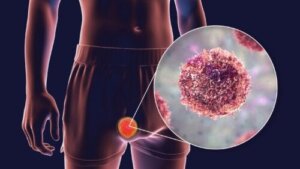Teratoma Tumors: Types, Symptoms and Treatment

Teratoma is a type of tumor that develops from pluripotent stem cells. The term comes from the Greek, where teratos means ‘monster’ and the suffix -oma, ‘tumor’. In other words, it literally means monstrous tumor.
The reason they were so named is because they have an odd appearance. They can contain hair, teeth, muscle, and bone, among other tissues. Pluripotent stem cells are the ones that can give rise to all types of cells and tissues, and this is why these structures can develop.
However, most tumors of this type are benign. However, they can sometimes lead to complications due to their size or location. In rare cases they become malignant. Below, we’ll tell you in detail what their main characteristics are and how they’re treated.
What is a teratoma?
A teratoma is a type of tumor. They’re congenital, which means they’re present from birth. As explained in a publication by the National Cancer Institute, it’s a tumor that forms from germ cells.
Specifically, from pluripotent stem cells. This means that cells from all the germ layers of the embryo can develop inside them. Therefore, they often consist of different types of tissue. For example, hair, teeth, bone or cartilage.
Teratomas tend to be located in the ovaries of women or in the testicles of men. However, they can also appear in the central nervous system, the thorax, the abdomen, or even in the coccygeal bone.
Most of them are benign, and don’t produce distant metastases. However, some can still be malignant and may spread or grow aggressively to damage surrounding tissues.
Types of teratoma
Teratomas can be classified into different types. Most often they’re distinguished according to whether they’re benign or malignant. They can also be classified according to their location. We explain this in the following sections.
Mature or benign teratoma
A mature or benign teratoma is one that is formed by mature cells, as the name suggests. They grow slowly, although they can reach a large size. So much so that, although their average size ranges between 5 and 15 centimeters (2 to 6 inches), they can even reach 45 centimeters (18 inches).
The most frequent ones are located in the ovary. To be more precise, in the right ovary. However, they can also be located in the skull, the mediastinum, and the sacrococcygeal region, among others.
When it occurs in the ovary, it’s called a ‘dermoid cyst’. It’s usually diagnosed in women of childbearing age and is one of the most frequent ovarian tumors. Despite its benign nature, it can lead to complications if the woman becomes pregnant.
Immature or malignant teratoma
The immature or malignant teratoma, contrary to the previous one, is potentially cancerous. Fortunately, its incidence is much lower. It usually occurs in young people; in the case of men, it’s detected between the ages of 20 and 40.
Women usually develop it before the age of 20. It’s made up of immature and atypical cells. Depending on the degree of atypia and the extent of the tumor, it can be classified into different degrees of severity.
Other characteristics are as follows:
- It’s solid.
- Inside there are usually foci of necrosis (i.e. dead cells).
- It has immature tissues, such as connective tissue or even brain tissue.
The prognosis of this type of tumor is highly variable. It may require aggressive treatment, such as the removal of the ovary or testicle.
Teratomas according to their location
Depending on where the teratoma develops, the name given to it will vary. The most frequent are sacrococcygeal and ovarian teratomas. Sacrococcygeal teratomas can, in turn, appear in two different ways.
Most often they’re large, benign tumors. They tend to protrude from the sacral bone area. For this reason, it’s common for them to be detected during pregnancy by ultrasound. If not, then they’re easy to see after giving birth.
The other type of sacrococcygeal pattern is a small tumor, located in front of the sacrum. This type causes the baby’s buttocks to feel somewhat asymmetrical. If left untreated, as it grows it can cause damage to the child’s bladder or bowel.
Meanwhile, ovarian teratomas – as we noted in the previous section – are usually benign. Most are detected when carrying out tests for other conditions, as they’re usually asymptomatic.
Symptoms of a teratoma
The symptoms of teratomas are highly variable. They depend mainly on the location and size of the tumor. In addition, in the case of children, the interpretation of the symptoms or the way they’re expressed is different for each child.
In some cases, it’s possible for the tumor to be felt or even sensed through the skin. When it’s located near the sacral bone, it’s common for the mass to press on the bowel or bladder.
It is, therefore, common to find constipation, urinary incontinence, or alterations in the strength of the extremities. However, we must emphasize once again that many cases are asymptomatic.
It should be noted that they cause certain analytical alterations. As they’re germ cell tumors, hormones typical of immature tissues may be high. For example, there are usually high levels of alpha-fetoprotein or human chorionic gonadotropin.
What can cause them?
Teratoma is a tumor that develops from germ cells. These cells are the ones that give rise to the tissues that make up the reproductive system. They’re usually located in the gonads, that is, in the ovaries in the case of females, and in the testicles in males.
However, a small percentage can occur outside these organs. Because of this, it’s possible for them to have an extragonadal location. The exact mechanism by which they develop isn’t known. Some scientists believe that certain germ cells accidentally migrate to other parts of the body.
Normally, these cells die. However, in the case of teratomas, this mechanism fails, as explained in a publication by the National Organization for Rare Disorders. These cells continue to divide, giving rise to the tumor.
In the specific case of sacrococcygeal teratomas, they appear to arise from a particular area below the coccyx. This is the so-called ‘Henson’s node’, an area where germ cells are prevalent.
Although the exact cause of teratomas isn’t known, they’re often associated with other hereditary defects. For example, anomalies of the urinary system, the lower spine, or defects of the central nervous system.
How are teratomas diagnosed and treated?
The diagnosis of teratomas can be made in different ways. As we have mentioned, sometimes a mass is observed or palpated which raises suspicion. Even, in some cases, prenatal ultrasound is sufficient. However, other complementary tests are usually required to confirm the diagnosis.
One of the most commonly used is a blood test. Imaging tests, such as magnetic resonance imaging and computed tomography, are particularly useful. Radiography can also be helpful. However, confirmation is made by biopsy.
Treatment of teratoma also varies depending on the symptoms and the type of tumor. If the tumor is benign, but affects neighboring organs, it usually requires surgical removal.
In the case of a malignant teratoma, in addition to surgery, other more aggressive treatments are necessary. For example, chemotherapy and radiotherapy. Hemotherapy, which interferes with the cancer cells’ ability to grow, can also be used.
Care and recommendations
Teratomas require special care and treatment when they’re detected in a child. Follow-up visits are usually performed every six months or yearly. The goal is to detect early if recurrences or any complications of the tumor occur.
At these visits, the child will probably have to undergo a thorough physical examination. Imaging tests and blood tests are also usually ordered to look for any abnormalities.
What to remember
A teratoma is a tumor made up of germ cells. These are cells that can give rise to any type of tissue. Most are benign, but they aren’t exempt from causing complications. Hence, it’s essential to make an early diagnosis and a thorough follow-up of each case.
All cited sources were thoroughly reviewed by our team to ensure their quality, reliability, currency, and validity. The bibliography of this article was considered reliable and of academic or scientific accuracy.
- Alwazzan, A. B., Popowich, S., Dean, E., Robinson, C., Lotocki, R., & Altman, A. D. (2015). Pure Immature Teratoma of the Ovary in Adults: Thirty-Year Experience of a Single Tertiary Care Center. International journal of gynecological cancer : official journal of the International Gynecological Cancer Society, 25(9), 1616–1622. https://www.ncbi.nlm.nih.gov/pmc/articles/PMC4623850/
- Diccionario de cáncer del NCI. (s. f.). Instituto Nacional del Cáncer. https://www.cancer.gov/espanol/publicaciones/diccionarios/diccionario-cancer/def/teratoma
- Fayez, I., Khreisat, B., Athamneh, T., Omoosh, R., & Daibes, M. A. (2018). Multiple Bilateral Ovarian Mature Cystic Teratomas with Ovarian Torsion: A Case Report. Oman medical journal, 33(2), 163–166. https://www.ncbi.nlm.nih.gov/pmc/articles/PMC5889834/
- Farci, F. (2023, 2 enero). Testicular Teratoma. StatPearls – NCBI Bookshelf. https://www.ncbi.nlm.nih.gov/books/NBK567728/
- National Organization for Rare Disorders. (2023, 12 enero). Sacrococcygeal Teratoma – Symptoms, Causes, Treatment | NORD. https://rarediseases.org/rare-diseases/sacrococcygeal-teratoma/
- Romito, A., & Cobellis, G. (2016). Pluripotent Stem Cells: Current Understanding and Future Directions. Stem cells international, 2016, 9451492. https://www.ncbi.nlm.nih.gov/pmc/articles/PMC4699068/
- Sinchitullo Rosales, A. O. ., & Salvador, Z. (2019). ¿Qué es un teratoma? – Definición, tipos, causas y síntomas. Reproducción Asistida ORG. https://www.reproduccionasistida.org/teratoma/
-
Yadav, D. K., Acharya, S. K., Bagga, D., Jain, V., Dhua, A., & Goel, P. (2020). Sacrococcygeal Teratoma: Clinical Characteristics, Management, and Long-term Outcomes in a Prospective Study from a Tertiary Care Center. Journal of Indian Association of Pediatric Surgeons, 25(1), 15–21. https://www.ncbi.nlm.nih.gov/pmc/articles/PMC6910050/
This text is provided for informational purposes only and does not replace consultation with a professional. If in doubt, consult your specialist.









